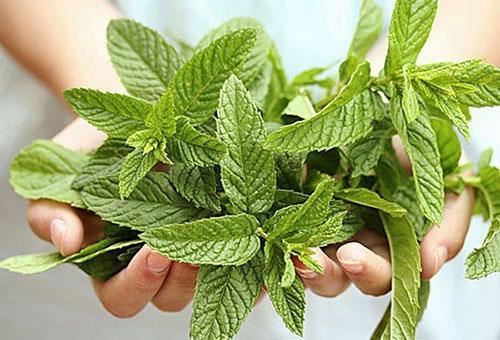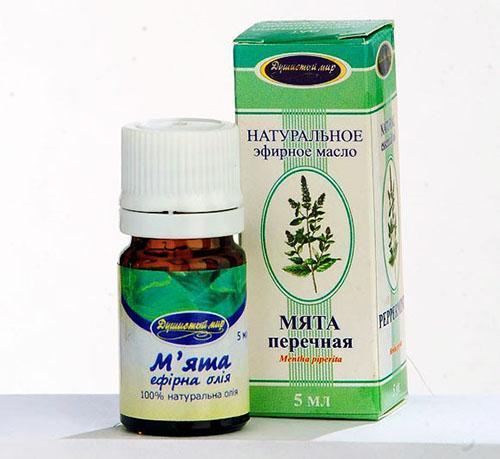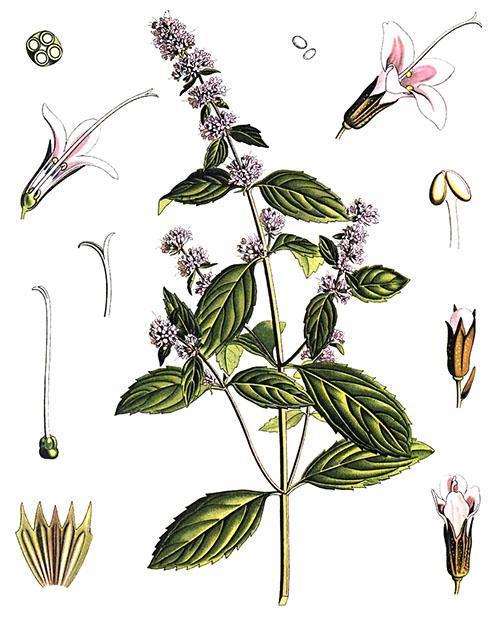Let's be familiar: peppermint medicinal properties and contraindications
 At any dacha, in the garden, there has long been a place for spicy healing peppermint. This unpretentious herb is used in home cooking along with other plants - dill, parsley, oregano. On the other hand, the herb has medicinal properties. Decoctions and infusions are used in folk medicine, oil and tinctures are produced industrially. Well-studied medicinal properties peppermint and contraindications to its use.
At any dacha, in the garden, there has long been a place for spicy healing peppermint. This unpretentious herb is used in home cooking along with other plants - dill, parsley, oregano. On the other hand, the herb has medicinal properties. Decoctions and infusions are used in folk medicine, oil and tinctures are produced industrially. Well-studied medicinal properties peppermint and contraindications to its use.
Characteristics of the chemical composition of mint
The essential oil, which is a mixture of menthol and its derivatives, gives a special aroma to peppermint leaves. In addition, organic cyclic compounds are present in the leaves:
- camphene;
- limonene;
- pinned;
- cineole;
- pullegon;
- meyanton.
Together with menthol compounds and essential oils, they make up 60% of the chemical elements extracted from peppermint leaves. The rest are biologically active additives, organic acids, anthocyanins, azulenes and trace elements. Such a saturated content of substances necessary for a person is 3% of the weight of the green mass. Naturally, the properties of peppermint have found application and the plant is cultivated on an industrial scale.
Peppermint medicinal uses

- peppermint oil;
- mint tincture, or mint drops;
- pharmacy fees from mint;
- dry briquetted products;
- complexes "Validol", "Corvalol", "Valokardin".
Knowing the beneficial properties of peppermint and contraindications, you can use the herb harvested on your own at home. It can be used not only for medicinal purposes, but in cooking and perfumery.
Before the feast, the servants of the patricians rubbed the tables with mint and sprayed the walls with infusion, bringing the smell of freshness into the room. And the soldiers were forbidden to drink infusion of mint before the battle, as it was believed that "Aphrodite's Herb" reduces militancy.
The healing property of mint is based on the action of the substance menthol. When the substance comes into contact with the skin or mucous membrane, menthol irritates the nerve endings. A tingling or cooling signal is transmitted. In this case, the blood vessels receive a signal to narrow, retaining heat, and the internal vessels expand, thereby relieving spasm and pain. It has a beneficial effect on attacks of angina pectoris, reduces headache, improves the work of the veins, and enhances the work of the gastrointestinal tract. Peppermint has a beneficial effect on the liver and bile ducts, the composition of bile changes.
 On the basis of the complex action of the components extracted from the mint, many dosage forms are being prepared. One of the drugs is peppermint tincture. Under factory conditions, the extraction of medicinal elements from the green mass occurs by extraction with ethyl alcohol of the active substances. In its official form, peppermint tincture (Tinctura Menthae piperitae) consists of equal parts oil and alcohol extract.
On the basis of the complex action of the components extracted from the mint, many dosage forms are being prepared. One of the drugs is peppermint tincture. Under factory conditions, the extraction of medicinal elements from the green mass occurs by extraction with ethyl alcohol of the active substances. In its official form, peppermint tincture (Tinctura Menthae piperitae) consists of equal parts oil and alcohol extract.
At home, a tincture is prepared by mixing equal weight fractions of ethyl alcohol or purified moonshine and mint leaves.After insisting in a warm, dark place for 20 days, the resulting liquid is cleared of suspension and stored in a dark cool place.
Instructions for using peppermint tincture include using it for problems:
- as a pain reliever for neuralgia;
- antiemetic and carminative;
- with vascular tone, high blood pressure, poor blood circulation;
- insomnia and cerebral nutrition.
However, this medication should not be abused. Uncontrolled use of menthol drops can cause spasm of the respiratory organs, up to respiratory arrest. Therefore, for chronically ill people, you should consult a doctor before using the peppermint elixir.
 Produced mint oil (Ol. Menth. Pip.) Is applied topically. The analgesic effect is achieved by rubbing into the temporal part, with pain and itching of the skin, relieves the condition with insect bites. This is how the famous Zvezdochka ointment works. Internal use of oil is possible only as directed by a doctor.
Produced mint oil (Ol. Menth. Pip.) Is applied topically. The analgesic effect is achieved by rubbing into the temporal part, with pain and itching of the skin, relieves the condition with insect bites. This is how the famous Zvezdochka ointment works. Internal use of oil is possible only as directed by a doctor.
 In folk medicine, an herbal infusion is used. It is used for indigestion, for colds, as a sedative. Mint tea is used more often. It is brewed and allowed to brew. Then they are used with honey or alone. This tea is especially useful for insomnia. It is noted that tea is poorly tolerated by patients with stomach ulcers.
In folk medicine, an herbal infusion is used. It is used for indigestion, for colds, as a sedative. Mint tea is used more often. It is brewed and allowed to brew. Then they are used with honey or alone. This tea is especially useful for insomnia. It is noted that tea is poorly tolerated by patients with stomach ulcers.
The benefits and harms of peppermint depend on many reasons. Since menthol lowers blood pressure, soothes, lowers activity, it should not be taken by people driving vehicles. For people with low blood pressure, this substance is also prohibited. You cannot drink mint tea for a nursing mother, as lactation decreases and the addition of mint in milk will harm the baby.
When can you collect peppermint and how to make a harvest correctly
 The highest concentration of nutrients in medicinal raw materials is present in the budding phase. This is usually in June or July, depending on the region. Cut twigs are laid out in the shade in a ventilated place. Before drying the raw materials, you need to rinse the leaves. Some do it after the harvest, while others arrange shower mint in the garden. In this case, cleaning begins after the leaves have dried.
The highest concentration of nutrients in medicinal raw materials is present in the budding phase. This is usually in June or July, depending on the region. Cut twigs are laid out in the shade in a ventilated place. Before drying the raw materials, you need to rinse the leaves. Some do it after the harvest, while others arrange shower mint in the garden. In this case, cleaning begins after the leaves have dried.
When drying mint, do not use a drying oven, as light ethers will evaporate. At home, the dried material is stored in linen bags or tight-fitting glass jars.
When harvesting from large plantations, the cut grass is dried under a canopy, tedding with a pitchfork. The sheet material is used for packaging for sale and for use in fees. The remaining twigs are used to extract essential oils and prepare liquid forms. According to GOST, pharmaceutical raw materials must be a mass of crushed sheets without the inclusion of blackened plates.